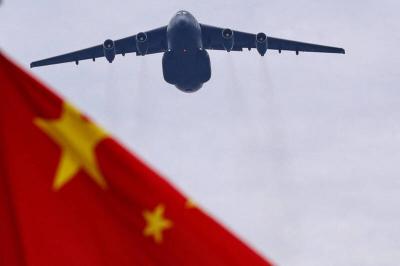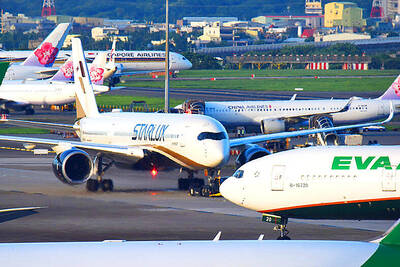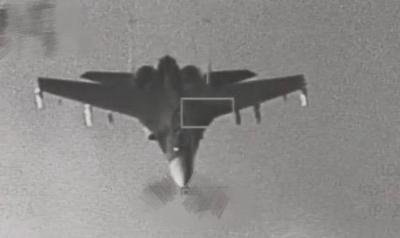The Republic of China’s (ROC) claim over the disputed South China Sea conforms with international law, President Ma Ying-jeou (馬英九) said yesterday, adding that critics of the claim who say it is identical to that of the People’s Republic of China (PRC) have “not an ounce of common sense.”
After Ma on Tuesday proposed the “South China Sea peace initiative,” the Democratic Progressive Party (DPP) demanded more clarity to ensure compliance with international law and the 1982 UN Convention on the Law of the Sea and questioned whether Ma intends to join with China in asserting the claim.
The concerns voiced by the DPP were similar to views repeatedly expressed by some former US officials and academics that Taiwan should clarify its position on the demarcation line, known as the “11-dash line,” used to lay its claim to the entire South China Sea, as they said that the assertion has no basis in international law.

Photo: CNA
China’s claim to the South China Sea is demarcated similarly by the “nine-dash line.”
Ma rejected the DPP’s criticism yesterday, when he received international guests who attended the International Law Association and American Society of International Law Asia-Pacific Research Forum in Taipei on Tuesday.
“The opposition has said that our [sovereignty] contention echoed that of the Chinese Communist Party (CCP) regime. This view reflects that they have not an ounce of common sense. We [the ROC] made the sovereignty claim in 1947, when the [PRC] was not in existence. The CCP did not establish the regime until 1949,” Ma said.
“It is the mainland [China] that emulates our claims, not the other way around,” he said.
The ROC government has dealt with international affairs in line with international law, as required by Article 141 of the ROC Constitution, Ma said.
“Especially on the South China Sea, the ‘Location Map of the Islands in the South China Sea (南海諸島位置圖)’ published in 1947 clearly states our claims,” Ma said. “The claims remain unchanged.”
DPP Secretary-General Joseph Wu (吳釗燮) on Tuesday said that Ma’s peace initiative — which calls for claimants to set aside sovereignty disputes and jointly explore resources — would only be a slogan if Ma failed to clarify the two points.
Ma dismissed Wu’s concerns.
“It was not just a view expressed on paper and not just a slogan. We have seen how the peace initiative is being put into practice in East China Sea,” Ma said, citing the signing of a fisheries agreement between Taiwan and Japan aimed at ending controversies over fishing in waters surrounding the contested Diaoyutai Islands (釣魚台) as an example.
After he proposed the East China Sea peace initiative, it took Taiwan and Japan just five months to conclude negotiations on the agreement, Ma said.
According to a report by GMA News Online from Manila, the Philippines, one of the claimants in the South China Sea, is not keen to adopt Ma’s proposal.
When asked for a comment on Ma’s proposal at a press briefing on Tuesday, Philippine Secretary of Communications Herminio Coloma said that Manila will pursue only two tracks to resolve the dispute: international arbitration and coordination with other Southeast Asian countries, the GMA reported.
Acting US Department of State deputy spokesperson Jeff Rathke, asked to comment on the initiative at a press briefing on Tuesday, said: “We, of course, appreciate Taiwan’s call on claimants to exercise restraint, to refrain from unilateral actions that could escalate tensions and to respect international law, as reflected in the Law of the Sea Convention.”
Rathke said the US does not take a position on the sovereignty of land features.
Asked to comment on the legality of the claims of Taiwan and of China, Rathke said the US has consistently called on China to clarify its “nine-dash line” claim to explain its justification under international law.
“We think that if China were to do that, that would be a helpful contribution,” he said.
Meanwhile, the Chinese Nationalist Party (KMT) caucus yesterday said it “strongly” supported Ma’s South China Sea peace initiative, saying that the plan that aims to “shelve sovereignty disputes and calls for cooperation among neighboring countries in the development of the resources” was “visionary.”
“During the seven years Ma has been in office, the defense of Taiping Island (太平島) [also known as Itu Aba Island] has greatly improved, but with the island being 1,600km away from Taiwan proper, it would be hard to guard our interests there solely with military power,” KMT Legislator Lin Yu-fang (林郁方) said. “That’s why [Ma] tabled the initiative: to protect our claims in the related regions by dint of diplomatic means. So there should be nothing in the initiative for the DPP to criticize.”
Additional reporting by Alison Hsiao

Beijing could eventually see a full amphibious invasion of Taiwan as the only "prudent" way to bring about unification, the US Department of Defense said in a newly released annual report to Congress. The Pentagon's "Annual Report to Congress: Military and Security Developments Involving the People's Republic of China 2025," was in many ways similar to last year’s report but reorganized the analysis of the options China has to take over Taiwan. Generally, according to the report, Chinese leaders view the People's Liberation Army's (PLA) capabilities for a Taiwan campaign as improving, but they remain uncertain about its readiness to successfully seize

Taiwan is getting a day off on Christmas for the first time in 25 years. The change comes after opposition parties passed a law earlier this year to add or restore five public holidays, including Constitution Day, which falls on today, Dec. 25. The day marks the 1947 adoption of the constitution of the Republic of China, as the government in Taipei is formally known. Back then the Chinese Nationalist Party (KMT) governed China from Nanjing. When the KMT, now an opposition party in Taiwan, passed the legislation on holidays, it said that they would help “commemorate the history of national development.” That

Trips for more than 100,000 international and domestic air travelers could be disrupted as China launches a military exercise around Taiwan today, Taiwan’s Civil Aviation Administration (CAA) said yesterday. The exercise could affect nearly 900 flights scheduled to enter the Taipei Flight Information Region (FIR) during the exercise window, it added. A notice issued by the Chinese Civil Aviation Administration showed there would be seven temporary zones around the Taiwan Strait which would be used for live-fire exercises, lasting from 8am to 6pm today. All aircraft are prohibited from entering during exercise, it says. Taipei FIR has 14 international air routes and

The Ministry of National Defense (MND) today released images of the military tracking China’s People's Liberation Army (PLA) movements during the latest round of Chinese drills around Taiwan. The PLA began "Justice Mission 2025" drills today, carrying out live-fire drills, simulated strikes on land and maritime targets, and exercises to blockade the nation's main ports. The exercises are to continue tomorrow, with the PLA announcing sea and air space restrictions for five zones around Taiwan for 10 hours starting from 8:30am. The ministry today released images showing a Chinese J-16 fighter jet tracked by a F-16V Block 20 jet and the